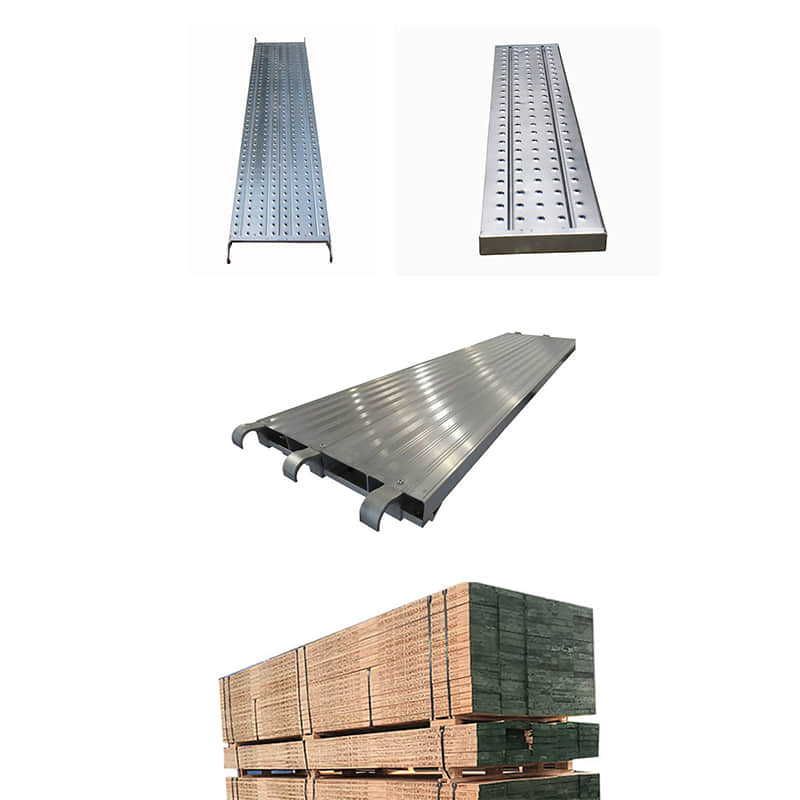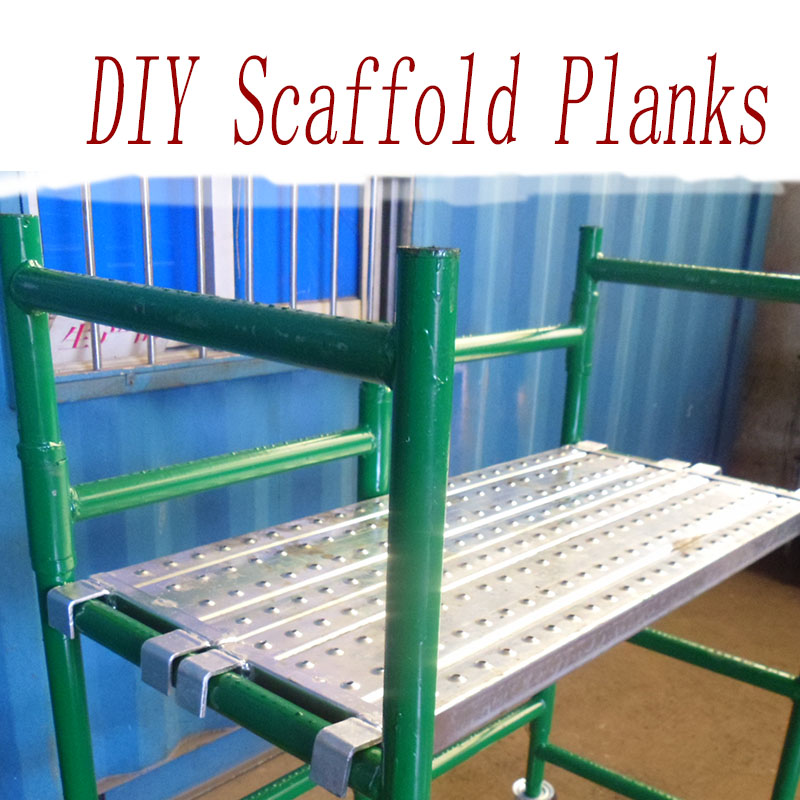Le guide ultime du bricolage pour les planches d'échafaudage : construisez en toute sécurité et de manière créative
May 20, 2025
Les planches d'échafaudage (aussi appelées planches d'échafaudage) sont essentielles pour la construction, la rénovation et même les projets de bricolage créatifs. Que vous construisiez une plateforme d'échafaudage temporaire ou que vous transformiez de vieilles planches d'échafaudage en meubles, ce guide vous permettra d'acquérir de nombreuses connaissances sur les projets de bricolage avec des planches d'échafaudage. Que sont les planches d’échafaudage ? Les planches d'échafaudage sont des planches plates en bois, en métal ou en matériaux composites, conçues comme plateformes de travail sur les échafaudages. Elles sont destinées à soutenir les travailleurs et le matériel en offrant une surface stable et plane lors des travaux nécessitant une certaine hauteur pour la construction, la réparation ou l'entretien. Types de planches d'échafaudage Planches d'échafaudage en bois -Traditionnellement fabriqué à partir de bois dur massif (par exemple, épicéa, pin ou sapin). -Doit répondre à une norme de résistance et de durabilité (par exemple OSHA ou EN 12811). -Devient progressivement obsolète en raison des risques d'éclatement, de déformation et de pourriture. Planches en acier ou en aluminium -Léger, durable et incombustible. -Souvent fourni avec un échafaudage système (par exemple, ringlock, cuplock). -Non poreux et résistant à l'humidité, aux insectes et à l'usure. Planches d'échafaudage composites (fibre de verre ou plastique) -Idéal pour les projets électriques puisque les matériaux composites sont naturellement non conducteurs. -Résistant aux produits chimiques, aux rayons UV et aux conditions météorologiques extrêmes. -Plus léger que l'acier, mais plus cher. Normes de sécurité primaires -OSHA (USA) : Les planches d'échafaudage doivent supporter au moins quatre fois leur charge prévue. -EN 12811 (Union européenne) : Définit les limites de résistance, de déflexion, de résistance au glissement, etc. -ANSI/ASSE A10.8 : Matériaux des planches d'échafaudage, inspection et définitions de la capacité de charge. Choisir les bonnes planches d'échafaudage pour les projets de bricolage La sélection des bonnes planches d’échafaudage garantira la sécurité, la stabilité et la productivité lors de la réalisation d’un projet de construction. 1. Identifiez tous vos besoinsType de projet : Travaux légers (peinture, nettoyage de vos gouttières) ou lourds (travaux de construction ou de maçonnerie).Hauteur et portée : À quelle hauteur travaillerez-vous ? Aurez-vous besoin de longues planches pour atteindre la zone étudiée ?Fréquence d'utilisation : S'agira-t-il d'un travail ponctuel ou souhaitez-vous réutiliser les planches d'échafaudage pour d'autres projets ? 2. Types de planches d'échafaudage pour le bricoleurPlanches de bois (économiques) Elles sont peu coûteuses et se trouvent partout (bois durs comme l'épicéa et le pin). Légères, elles se découpent facilement aux dimensions souhaitées pour la planification. Elles peuvent se déformer, se fissurer ou pourrir. Vérifiez régulièrement vos planches pour détecter les échardes et vérifier leur intégrité structurelle. Planches en aluminium ou en acier (utilisation à long terme)Ils sont solides, durables et résistent aux intempéries. Ils ne se plient pas et ne se fendillent pas comme le bois. Cependant, ils coûtent plus cher, sont plus lourds que le bois (mais plus légers que l'acier) et conviennent aux bricoleurs ou aux travaux plus lourds (par exemple, toiture, bardage). Planches composites/fibre de verre (travaux spécialisés)Les panneaux composites/fibre de verre sont utilisés pour les travaux électriques. Ils résistent aux produits chimiques, à l'humidité et aux rayons UV. Cependant, ils sont généralement coûteux. Consultez les prix et les spécifications car, selon vos besoins, ils peuvent être plus lourds que le bois et plus légers que l'acier. Ils sont généralement acceptables pour les travaux à proximité de lignes électriques ou en cas d'intempéries. Conseils de sécurité pour travailler avec des planches d'échafaudage Insistez sur la vérification des dommages avant utilisation.N’oubliez pas la capacité de charge – Assurez-vous que les planches peuvent supporter votre poids + vos outils/matériaux (l’OSHA suggère 4 fois la charge prévue).Attention aux surplombs – Les planches doivent dépasser d’au moins 6 pouces de vos supports, mais pas trop.Vérifiez avant utilisation – Recherchez les fissures, les courbures et la pourriture (cela semble étrange, mais surtout avec du bois).Vérifiez que tout ce qui soutient la planche est bon – N’utilisez jamais d’objets instables (comme des chaises ou des tables) comme bases d’échafaudage.Fixez la planche – Cela signifie que vous devez l’attacher ou utiliser des crochets d’échafaudage ou quelque chose pour l’empêcher de bouger.Fixez-le correctement avec des pinces/supports si vous construisez une plate-forme temporaire.Portez toujours des gants et des lunettes de sécurité lors de la coupe ou du ponçage. Projets créatifs de planches d'échafaudage à faire soi-même 1. Étagères en planches d'échafaudageMatériaux - 1 ou 2 planches d'échafaudage, supports, visProcessus - Poncer et teindre les planches d'échafaudage. - Fixer les supports au mur. - Fixez les planches aux supports pour créer une étagère rustique. 2. Table basse en planches d'échafaudageMatériaux - 4 planches d'échafaudage, pieds en épingle à cheveux, colle à boisProcessus - Collez les planches ensemble par paires, côte à côte. - Poncer pour lisser et appliquer le vernis. - Fixez les pieds en métal pour un style industriel. 3. Terrasse de jardin en planches d'échafaudageMatériaux - Un certain nombre de planches d'échafaudage, de solives, de vis. Processus - Solives comme base. - Visser les planches sur les planches en laissant de petits espaces pour le drainage. - Traiter avec un produit de préservation du bois extérieur. 4. Établi en planches d'échafaudageMatériaux - 2 ou 3 planches d'échafaudage, 2 ou plusieurs chevalets ou un cadre métallique.Processus - Si vous utilisez des chevalets, fixez les planches d'échafaudage sur les chevalets pour créer un établi temporaire. - Fixez un étau ou des crochets pour suspendre les outils. Entretien et traitement des planches d'échafaudage Quel que soit le type de planches d'échafaudage que vous utilisez (bois, métal ou composite), un bon entretien est essentiel pour garantir sécurité, longévité et performance. Voici quelques conseils pour entretenir vos planches d'échafaudage. 1. Planches d'échafaudage en bois Considérations relatives à la maintenanceInspections régulières - recherchez :Fissures, fentes ou déformationsPourriture, moisissure ou dommages causés par les insectesNœuds lâches ou échardes NettoyageBalayer la saleté et les débris.Lavage à la main avec du savon doux + eau (ne pas utiliser de nettoyeur haute pression, cela pourrait endommager le bois). SéchageConservez-les dans un endroit sec et aéré, c'est indispensable pour éviter l'humidité. Traitement et protection� Huilage/Scellement (pour prolonger la durée de vie du bois)Une fois par an, appliquez de l'huile de lin ou un produit de préservation du bois.Ne peignez pas les planches de l'échafaudage. La peinture peut masquer les dommages structurels.� Fongicide et insectifugeUtilisez des solutions de borate pour les protéger de la pourriture et des termites.� Protection des bordsUtilisez des sangles métalliques pour renforcer les extrémités afin d'éviter les fissures. ⚠ Quand faut-il retirer les planches de bois ?-Lorsque les fissures sont plus profondes que ¼ de pouce.-Lorsqu'une flexion ou un affaissement se produit sous une charge légère. 2. Planches d'échafaudage en aluminium/acier Suggestions d'entretienInspectez les dommages – Recherchez :-Bosses, courbures et/ou corrosion-Rivets et/ou soudures desserrés Nettoyage-Essuyer avec un chiffon humide.-Utilisez une brosse métallique + un convertisseur de rouille pour éliminer la rouille. Lubrification-Utiliser un spray silicone sur les pièces mobiles (si elles sont réglables). Prévenir la rouille-Planches galvanisées ou revêtues de poudre - Meilleur choix pour une utilisation prolongée.-Peinture de retouche - Utilisez un émail antirouille sur les rayures. ⚠ Quand faut-il retirer les planches métalliques ?La corrosion affecte l’intégrité structurelle.Si un coude crée un profil concave ou convexe, cela affecte la planéité (risque de danger). 3. Planches composites/fibre de verreConseils d'entretienNettoyageLaver à l'eau et au savon + brosse douceN'UTILISEZ PAS DE PRODUITS CHIMIQUES AGRESSIFS (peuvent dégrader la résine) InspectionVérifiez le délaminage, les fissures et les dommages causés par les UV. Protection UVRevêtements ignifuges UV - aident à prolonger la durée de vie de vos planches dans les climats ensoleillés. Quand faut-il retirer les planches composites ?-Si des fissures ou des fentes profondes se développent.-Si la flexibilité commence à augmenter (c'est un signe que le matériau est peut-être fatigué). Conseils généraux de stockage- Conserver à plat - des déformations (bois) ou des courbures (métal) peuvent se produire.- Stocker hors du sol - de l'humidité/de la rouille peuvent se développer.-Couverture - utilisez des bâches pour le stockage extérieur. Rappels de sécurité-N'utilisez jamais de planches endommagées - Même de très petites fissures peuvent échouer lorsqu'elles sont chargées.-Suivez toujours les instructions du fabricant - limitations de poids et conditions d'utilisation.-Étiquetez vos planches - Gardez des notes sur les dates d'inspection, les réparations, etc. Conclusion Les planches d'échafaudage sont incroyablement polyvalentes pour les projets d'échafaudage DIY. Que vous recycliez de vieilles planches d'échafaudage ou construisiez une plateforme de travail robuste, privilégiez toujours la sécurité et un traitement approprié.Vous souhaitez acheter des marches d'échafaudage pour votre projet, vous pouvez contacter Bâtiment AJNous vous fournirons des devis et des solutions de qualité. FAQ Quelle taille dois-je choisir pour ma planche d'échafaudage ?Les tailles standard varient, mais les tailles standard incluent :- Longueur : 6 pieds, 8 pieds, 10 pieds ou 12 pieds (les autres longueurs sont considérées comme personnalisées).- Largeur : 9,5" à 12" (note aux utilisateurs de planches d'échafaudage ; les planches plus larges offrent plus de stabilité).- Épaisseur : 1,5" à 2" (note aux utilisateurs de planches d'échafaudage ; les planches plus épaisses supportent des charges plus lourdes). Quelle est la capacité de charge d'une planche d'échafaudage ?La capacité de charge varie en fonction du type de matériau et de son épaisseur :- Types de bois : Généralement 150 à 250 lb par pied carré.- LVL/Bois d'ingénierie : jusqu'à 300+ lb par pied carré.- Aluminium : dépend de la conception, mais offre généralement une capacité de charge élevée.Nous vous recommandons de toujours vérifier les cotes fournies par les fabricants et les normes de sécurité (OSHA, EN 12811). En savoir plus Quelle est la meilleure façon de fabriquer moi-même ma propre planche d'échafaudage au lieu de dépenser 200 $ pour cela ? —— Reddit .r/ToolsPlanches pour échafaudages - Forums LOSH —— Forums lOSH

